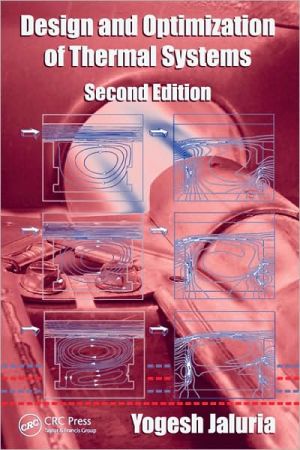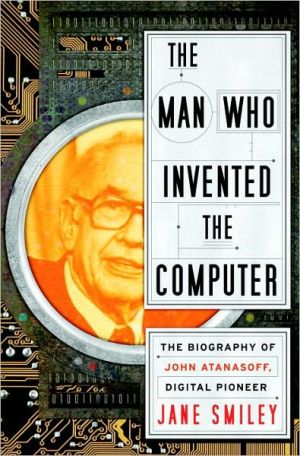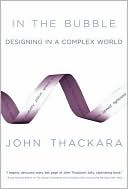Design and Optimization of Thermal Systems
Thermal systems play an increasingly symbiotic role alongside mechanical systems in varied applications spanning materials processing, energy conversion, pollution, aerospace, and automobiles. Responding to the need for a flexible, yet systematic approach to designing thermal systems across such diverse fields, Design and Optimization of Thermal Systems, Second Edition provides hands-on guidance needed to solve practical and progressively complex design problems.\ This bookoffers a thorough...
Search in google:
Thermal systems play an increasingly symbiotic role alongside mechanical systems in varied applications spanning materials processing, energy conversion, pollution, aerospace, and automobiles. Responding to the need for a flexible, yet systematic approach to designing thermal systems across such diverse fields, Design and Optimization of Thermal Systems, Second Edition provides hands-on guidance needed to solve practical and progressively complex design problems.This bookoffers a thorough examination of basic concepts and procedures for conceptual design, formulation, modeling, simulation, feasible design, and optimization. The chapters encompass traditional as well as emerging techniques, featuring timely and compelling examples to demonstrate the range of potential problems and available solutions that readers may apply to their own needs.Maintaining its emphasis on mathematical modeling and simulation techniques, this revised edition offers extended coverage on manufacturability, material selection, and sensitivity. It includes new material on genetic and gradient search methods and highlights significant trends such as knowledge-based design methodology. This edition also updates and enhances its coverage of important economic, safety, security, and environmental aspects and considerations. Booknews A senior undergraduate or first-year graduate level textbook employing examples from diverse areas such as manufacturing, energy systems, cooling of electronic equipment, refrigeration, environmental problems, engines, and heat transfer equipment. Discusses the conceptual design and formulation of the design problem; development of a suitable model; numerical modeling and simulation; economic factors in design; the formulation of the optimization problems; applicable optimization methods; and recent trends, such as knowledge- based design methodology. Annotation c. by Book News, Inc., Portland, Or.
Introduction 1Engineering Design 2Design Versus Analysis 2Synthesis for Design 6Selection Versus Design 7Design as Part of Engineering Enterprise 9Need or Opportunity 9Evaluation and Market Analysis 10Feasibility and Chances of Success 12Engineering Design 14Research and Development 15Need for Optimization 16Fabrication, Testing, and Production 18Thermal Systems 19Basic Characteristics 19Analysis 22Types and Examples 25Outline and Scope of the Book 40Summary 43References 44Basic Considerations in Design 47Formulation of the Design Problem 47Requirements and Specifications 47Given Quantities 50Design Variables 51Constraints or Limitations 53Additional Considerations 55Conceptual Design 58Innovative Conceptual Design 58Selection from AvailableConcepts 62Modifications in the Design of Existing Systems 64Steps in the Design Process 70Physical System 72Modeling 75Simulation 76Evaluation: Acceptable Design 81Optimal Design 83Safety Features, Automation, and Control 86Communicating the Design 90Patents and Copyrights 92Computer-Aided Design 97Main Features 97Computer-Aided Design of Thermal Systems 98Material Selection 104Different Materials 104Material Properties and Characteristics for Thermal Systems 108Selection and Substitution of Materials 110Summary 113References 115Problems 116Modeling of Thermal Systems 125Introduction 125Importance of Modeling in Design 125Basic Features of Modeling 125Types of Models 128Analog Models 129Mathematical Models 130Physical Models 130Numerical Models 131Interaction Between Models 133Other Classifications 133Mathematical Modeling 134General Procedure 134Final Model and Validation 160Physical Modeling and Dimensional Analysis 165Dimensional Analysis 166Modeling and Similitude 176Overall Physical Model 180Curve Fitting 180Exact Fit 181Best Fit 183Summary 194References 196Problems 197Numerical Modeling and Simulation 207Numerical Modeling 208General Features 208Development of a Numerical Model 210Available Software 211Solution Procedures 212Linear Algebraic Systems 213Nonlinear Algebraic Systems 220Ordinary Differential Equations 227Partial Differential Equations 238Numerical Model for a System 247Modeling of Individual Components 248Merging of Different Models 251Accuracy and Validation 252System Simulation 253Importance of Simulation 254Different Classes 256Flow of Information 259Methods for Numerical Simulation 264Steady Lumped Systems 264Dynamic Simulation of Lumped Systems 272Distributed Systems 278Simulation of Large Systems 282Numerical Simulation Versus Real System 283Summary 284References 285Problems 286Acceptable Design of a Thermal System: A Synthesis of Different Design Steps 299Introduction 299Initial Design 300Design Strategies 309Commonly Used Design Approach 309Other Strategies 309Iterative Redesign Procedure 317Design of Systems from Different Application Areas 322Manufacturing Processes 323Cooling of Electronic Equipment 329Environmental Systems 336Heat Transfer Equipment 342Fluid Flow Systems 350Other Areas 361Design of Components Versus Design of Systems 361Additional Considerations for Large Practical Systems 362Summary 373References 374Problems 375Economic Considerations 383Introduction 383Calculation of Interest 385Simple Interest 385Compound Interest 385Continuous Compounding 387Effective Interest Rate 388Worth of Money as a Function of Time 390Present Worth 390Future Worth 391Inflation 393Series of Payments 396Future Worth of Uniform Series of Amounts 396Present Worth of Uniform Series of Amounts 397Continuous Compounding in a Series of Amounts 399Changing Amount in Series of Payments 400Shift in Time 402Different Frequencies 403Changes in Schedule 403Raising Capital 405Bonds 406Stocks 408Taxes 408Inclusion of Taxes 409Depreciation 410Economic Factor in Design 413Cost Comparison 413Rate of Return 417Application to Thermal Systems 419Summary 421References 421Problems 422Problem Formulation for Optimization 429Introduction 429Optimization in Design 429Final Optimized Design 431Basic Concepts 432Objective Function 432Constraints 434Operating Conditions Versus Hardware 437Mathematical Formulation 438Optimization Methods 440Calculus Methods 440Search Methods 441Linear and Dynamic Programming 442Geometric Programming 444Other Methods 444Optimization of Thermal Systems 447Important Considerations 447Different Approaches 448Different Types of Thermal Systems 449Examples 451Consideration of the Second Law of Thermodynamics 455Practical Aspects in Optimal Design 457Choice of Variables for Optimization 457Sensitivity Analysis 459Dependence on Objective Function: Trade-Offs 461Multi-Objective Optimization 462Part of Overall Design Strategy 464Change of Concept or Model 465Summary 466References 467Problems 468Lagrange Multipliers 473Introduction to Calculus Methods 473The Lagrange Multiplier Method 475Basic Approach 475Physical Interpretation 477Significance of the Multipliers 485Optimization of Unconstrained Problems 486Use of Gradients for Optimization 487Determination of Minimum or Maximum 487Conversion of Constrained to Unconstrained Problem 489Optimization of Constrained Problems 491Applicability to Thermal Systems 494Use of Curve Fitting 494Examples 495Inequality Constraints 499Some Practical Considerations 500Computational Approach 501Summary 503References 504Problems 505Search Methods 511Basic Considerations 511Importance of Search Methods 512Types of Approaches 513Application to Thermal Systems 514Single-Variable Problem 515Uniform Exhaustive Search 517Dichotomous Search 519Fibonacci Search 521Golden Section and Other Search Methods 523Comparison of Different Elimination Methods 524Unconstrained Search with Multiple Variables 527Lattice Search 529Univariate Search 530Steepest Ascent/Descent Method 532Multivariable Constrained Optimization 537Penalty Function Method 537Search Along a Constraint 542Examples of Thermal Systems 547Summary 551References 553Problems 554Geometric, Linear, and Dynamic Programming and Other Methods for Optimization 559Geometric Programming 559Applicability 560Unconstrained Optimization 561Mathematical Proof 570Constrained Optimization 573Nonzero Degree of Difficulty 578Linear Programming 579Dynamic Programming 588Other Methods 590Summary 591References 592Problems 593Knowledge-Based Design and Additional Considerations 599Knowledge-Based Systems 599Introduction 600Basic Components 602Expert Knowledge 607Design Methodology 609Application to Thermal Systems 610Additional Constraints 621Professional Ethics 623Sources of Information 625An Overview of Design of Thermal Systmes 628Summary 631References 632Problems 633Design Projects 635Computer Programs 639Material Properties 659Interest Tables 679Heat Transfer Correlations 687Index 697
\ BooknewsA senior undergraduate or first-year graduate level textbook employing examples from diverse areas such as manufacturing, energy systems, cooling of electronic equipment, refrigeration, environmental problems, engines, and heat transfer equipment. Discusses the conceptual design and formulation of the design problem; development of a suitable model; numerical modeling and simulation; economic factors in design; the formulation of the optimization problems; applicable optimization methods; and recent trends, such as knowledge- based design methodology. Annotation c. by Book News, Inc., Portland, Or.\ \








